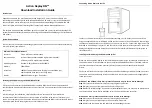
REV040218
SimpliPhi Power, Inc. | 420 Bryant Circle | Ojai, CA 93023, USA | (805) 640-6700 | [email protected] |
SimpliPhiPower.com
| 7 |
3.0 – Pre-Installation
The information within this section covers pre-installation procedures & considerations, namely, PHI 1.3
Battery performance parameters to be aware of during the design process, as well as guidance on
system sizing.
3.1 – PHI 1.3 Battery Performance Parameters and Sizing
Calculations
PHI 1.3 Batteries are designed to operate at a continuous C/2 rate across a large operating temperature
range, as seen in Table 1.0 above.
The PHI 1.3 Batteries need no increase in sizing and no special
compensations when determining the size of the energy storage and management system under the
circumstances and conditions seen in Table 1.0 above.
See specific inverter manufacturer program
settings for optimizing system integration.
PHI 1.3 Batteries do not need to be de-rated unless running continuously at more than 50% capacity, at
temperatures below 0 degrees Celsius, or above 49 degrees Celsius. To achieve higher, warrantied cycles
of 10,000+, the PHI 1.3 Batteries are typically operated at 80% maximum Depth of Discharge. Please
contact SimpliPhi Power Technical Support if alternative settings are desired. Please also refer to operating
temperatures and inverter settings in Programming section.
3.2 – System Sizing for Your Installation
The number of PHI 1.3 Batteries should be specified in terms of total storage capacity before the initial
installation based on the goals and objectives of the project. All PHI 1.3 Batteries are balanced during
final production and testing stages. Following proper wiring guidelines ensures that a system will not
require any manual balancing processes.
CAUTION:
Do not combine PHI 1.3 Batteries with other brands or chemistries. This will void the Warranty.
CAUTION:
Do not mix PHI 1.3 Batteries from different installations, clients or job sites. This will void the
Warranty.
4.0 – Installation & Wiring
This section covers basic concepts of system configuration as well as how to increase storage capacity
by wiring in parallel.
4.1 – Basic System Configuration Concepts
Safe and reliable installation requires trained and certified technicians. The following discussion of PHI 1.3
Battery configurations is a basic primer. Due to the variety of systems and components in the field, all
possible scenarios are not covered. This is not the purpose of this section of the manual. Refer to
professional installers regarding your system and its components and specifications. We encourage you or
your installer to contact us with any specific questions for technical support. We are committed to working
with you and your installation team to achieve a safe, reliable storage system that will provide years of
maintenance free service.
4.1.1 – System Wiring Basics
Refer to published electrical wiring specifications and ratings. All wire should be an appropriate
gauge and construction to handle the loads that will be placed upon it. Heavy gauge, high strand
copper wire is the industry standard due to its stability, efficiency and overall quality. A qualified
installer should understand this and must adhere to the industry standard and published electrical
guidelines.

































